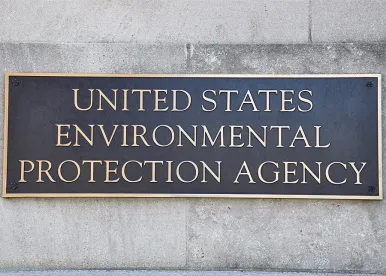In a memorandum dated January 25, 2018, and authored by newly appointed Assistant Administrator, Bill Wehrum, the United States Environmental Protection Agency (“EPA”) withdrew its “once in, always in” policy for the classification of major sources of hazardous air pollutants (“HAPs”) under section 112 of the Clean Air Act (“CAA”). Background Under EPA’s previous policy, facilities could switch to “area” source status at any time until the “first compliance date,” defined as “the first date a source must comply with an emission limitation or other substantive regulatory requirement.” Thereafter, facilities that were considered major sources for HAP were required to comply with the maximum achievable control technology (“MACT”) standard even if the facility no longer had the potential to emit (“PTE”) HAPs in a quantity less than the “major” source threshold. The CAA defines a “major source” as a source that “emits or has the [PTE] considering controls, in the aggregate,” 10 tons per year (“tpy”) or more any single HAP or 25 tpy or more of any combination of HAPs. An “area source” is defined as any stationary source that is not a “major source.” EPA’s New Policy Under EPA’s new policy, a facility considered a “major source” for emissions of HAPs may obtain reclassification as an “area” source at any time, provided the facility limits its PTE below EPA’s “major source” thresholds: 10 tpy of any single HAP or 25 tpy of any combination of HAPs). This is significant because the reclassified facility will no longer be subject to the major source MACT standard or other “major source” requirements under the CAA section 112. In support of its new position EPA reasoned that: Nothing in the structure of the CAA counsels against the plain language reading of the statute to allow major sources to become area sources after an applicable compliance date . . . Congress defined major sources differently and established different requirements for such sources. The [Once in, Always in] policy, by contrast, created an artificial time limit that does not exist on the face of the statute by including a temporal limitation of when a major source can become an area source by limiting its PTE. Next Steps EPA has twice proposed regulatory amendments that would have altered the “Once in, Always in” policy, but neither were finalized. EPA now plans to undergo a full notice and comment rulemaking to solicit comment on a rule to reflect EPA’s plain language reading of the CAA.
EPA Withdraws “Once In, Always In” Policy for the Classification of Major Sources of HAPs
Tuesday, January 30, 2018
Current Public Notices
Published: 22 August, 2025
Published: 20 August, 2025
Published: 20 August, 2025
Published: 18 August, 2025
Published: 18 August, 2025
Published: 18 August, 2025
Published: 15 August, 2025
Published: 14 August, 2025
Published: 12 August, 2025
Published: 11 August, 2025
Published: 8 August, 2025
Published: 21 July, 2025
Published: 18 July, 2025
Published: 26 June, 2025




 />i
/>i
